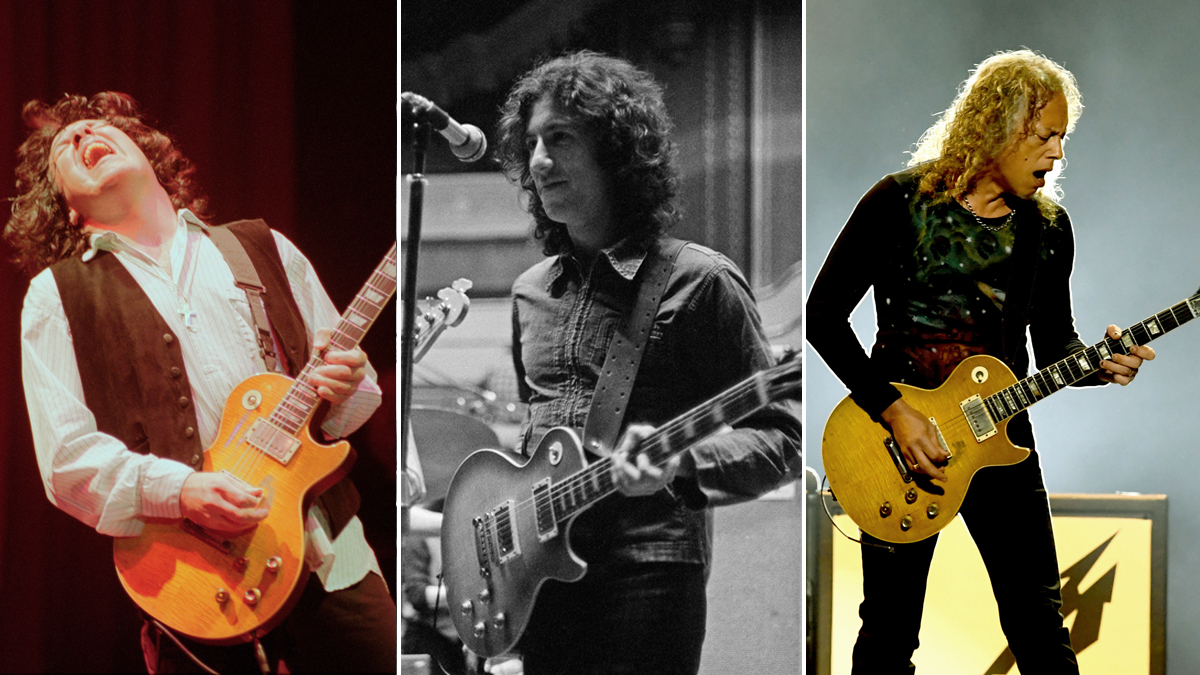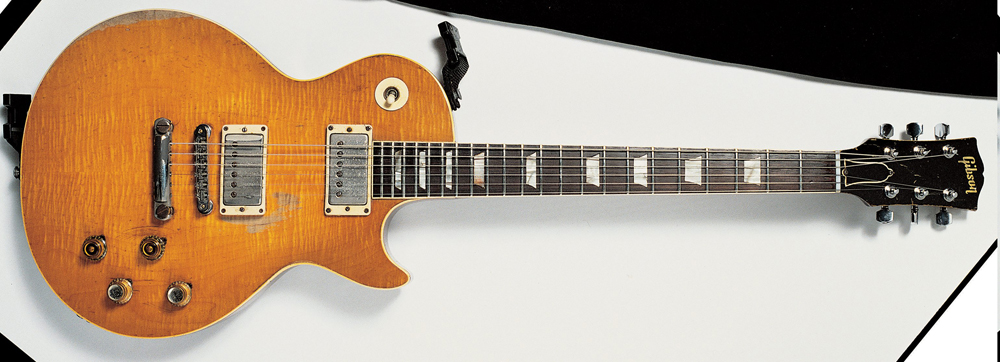6 times the legendary “Greeny” Gibson Les Paul was used to create electric guitar magic

In the annals of electric guitar history, few Gibson Les Pauls are as iconic as the one bearing the serial number 9 2208. That particular ‘59 Burst model is seen as one of the most legendary Les Pauls to ever exist, having passed through the hands of three iconic owners. We’re talking, of course, about the “Greeny” guitar.
Named after its first owner, Peter Green, the storied single-cut really needs no introduction. Acquired by the young English blues starlet around the time he was recruited to replace Eric Clapton full-time in John Mayall & The Bluesbreakers in 1966, the ‘59 Burst served Green faithfully throughout his all-too-brief musical career.
With its reversed neck humbucker and magical out-of-phase quack, “Greeny” is a guitar like no other – a Les Paul that can be identified from just a handful of notes from its mythical middle position, whose tone was accidentally conjured from a rewired neck pickup and a flipped magnetic polarity.

After using it to pen many famous Fleetwood Mac songs, Green began the process of passing the instrument through the generations when he sold it to Gary Moore at the turn of the ‘70s, who in turn made “Greeny” one of his go-to guitars for both Thin Lizzy and his solo career.
Now, it's in the possession of Metallica’s Kirk Hammett. Despite it being a somewhat controversial acquisition, Hammett has been admirably bearing the torch, continuing Moore and Green’s legacy by taking the one-of-a-kind Les Paul on-stage for fans to see in the flesh.
It's also a guitar undergoing something of a renaissance at the moment, after Gibson announced an ultra-exclusive Collector's Edition Greeny replica.
Hundreds of songs. Three high-profile owners. One iconic instrument. Here are six of Greeny’s most notable appearances throughout its storied career so far.
Get The Pick Newsletter
All the latest guitar news, interviews, lessons, reviews, deals and more, direct to your inbox!
1. John Mayall & The Bluesbreakers – The Super-Natural
Let's start where it all began, way back in 1966 when a 21-year-old Peter Green was given the unenviable task of filling in for blues guitar veteran Eric Clapton in John Mayall & The Bluesbreakers. Though the task was a mammoth one, Green quickly proved he was the right man for the job following the release of A Hard Road (1967), which introduced listeners to Green’s trademark style and tone on The Super-Natural.
The guitar instrumental is now mythical: famed for its ringing sustain, stinging vibrato, jaw-dropping melodic content, range-spanning dynamics and effortless fretboard migrations, The Super-Natural well and truly put Green – and his Les Paul tone – on the map for all to hear. Unsurprisingly, it wasn’t long before the young guitarist was dubbed one of the greatest English tone gods of the era.
2. Fleetwood Mac – Black Magic Woman
The “Greeny” Les Paul was used extensively by Green throughout his all-too-brief career, and served him particularly faithfully throughout his Fleetwood Mac days, which started almost as soon as his Bluesbreaker journey had begun. Opting to start his own band just a year later, Green would soon use his Les Paul to craft some of his finest pieces of guitar work.
Black Magic Woman is one such example. Littered with the same haunting sustain that made The Super-Natural so captivating, the 1968 single was Green at his absolute peak. With its Latin rhythm, minor key and Greeny’s honky tonk tone, the track is one of the best examples of Green’s musicality, showcasing some hair-rising licks and the same pinpoint bends that punctuated just about every one of his guitar solos.
Declining mental health brought on by a bad LSD trip caused Green to leave Fleetwood Mac and call it a day in the music industry at the turn of the decade. However, in just those four short years, Green had managed to cement both himself and his magical Les Paul in the annals of guitar history forever. Few players can attest to having a legacy quite so profound.
3. Gary Moore – Parisienne Walkways
When Green sought to pass on the “Greeny” mantle at the dawn of the ‘70s, he wanted to make sure his beloved single-cut ended up in the hands of a guitarist who would put it to good use. Gary Moore was the perfect candidate: a close friend of Green’s, Moore initially borrowed the Les Paul at the behest of Green himself.
Soon, Green would offer the guitar to Moore for around a measly £100. After Green refused to accept anything above that sum, Moore became the second official owner of “Greeny”, and the rest was history.
A standout track with which Moore often played using “Greeny” – though there are many – is his iconic solo single, Parisienne Walkways. Taken from Moore’s 1978 solo album Back on the Streets, the track is up there with Still Got The Blues as one of Moore’s most famous pieces of guitar playing. Lyrical in its lead lines and emotive in its delivery, Parisienne Walkways veered away from the clean nasal quack of Greeny's signature sound, and instead unleashed upon it Moore’s trademark high-gain tone.
4. Gary Moore – Need Your Love So Bad
In 1995, Moore put to record Blues For Greeny – an 11-track studio effort that comprised covers of Peter Green’s greatest hits, from If You Be My Baby to the already-mentioned The Super-Natural. Any track could be plucked from this list, but it’s the slow blues number Need Your Love So Bad that particularly demonstrates what made Moore and “Greeny” such a devastating combo.
Eight minutes long, Need Your Love So Bad is a masterful display of what Moore and “Greeny” were both capable of. The Northern Irishman’s phrasing is – as it was every time he picked up a guitar – immaculate, with the rendition featuring more than four minutes of heartfelt outro soloing.
Clean with a bit of its trademark bite, “Greeny” also brings its A-game to the table, helping Moore make his way through one of the best solos to feature on Blues For Greeny – one fueled by melancholic blues bends, emotive pentatonic turnarounds and scorching upper-register wails. Green couldn’t have cherry-picked a better custodian for his beloved Les Paul.
5. Kirk Hammett – The Green Manalishi (With The Two Prong Crown)
When Gary Moore sold Greeny for financial reasons back in 2006, it floated around the private collector’s ether for a while until it was snapped up by Metallica’s Kirk Hammett in 2014. Though the acquisition raised quite a few eyebrows at the time, one thing has become abundantly clear: Hammett is a worthy protector of the iconic Les Paul.
It goes everywhere with the Metallica maestro, who has successfully turned the blues-rock axe into an out-and-out metal machine all while respecting its heritage. Regularly cropping up on stage and in the studio, Hammett has used “Greeny” live on everything from Whiskey in the Jar to Fade to Black.
One of its most poignant appearances occurred just two years ago, when Hammett linked up with Mick Fleetwood, Pete Townshend, John Mayall and more to celebrate Peter Green’s music. Safe to say, his performance of The Green Manalishi – a track Green originally wrote using the iconic Les Paul – was a standout moment of the night.
“I’m not a guy who’ll buy a guitar just to stare at it and covet it; that is the death of a vintage guitar,” said Hammett, who has proved himself to be the ultimate Greeny owner. “Guitars are built to be played. The more they’re played, the better they sound.”
6. Joe Bonamassa – Midnight Blues
Prior to Hammett’s purchase, sightings of “Greeny” in the wild were borderline non-existent. However, as a man whose reputation precedes him when it comes to all-things-vintage, it should come as no surprise that today’s foremost Burst aficionado Joe Bonamassa once took “Greeny” for a spin back in 2013.
Playing host to JoBo’s setlist stalwart Midnight Blues, “Greeny” certainly had a task on its hands, though proved to the perfect foil for Bonamassa’s lightning-fast licks, decking out his recognizable high-gain blues rock tone with its nuanced, out-of-phase quack. That solo at 3:50 is a particular standout, and was probably the first time that old Brazilian rosewood fretboard received such a workout.
If Hammett should ever decide to part ways with “Greeny” in the near future, Bonamassa would most certainly be at the very top of the list of potential suitors. From what we can see in the video above – along with JoBo’s passion for vintage guitars – we don’t think that would be such a bad thing.

Matt is the GuitarWorld.com News Editor. He has a Masters in the guitar, a degree in history, and has spent the last 16 years playing everything from blues and jazz to indie and pop. When he’s not combining his passion for writing and music during his day job, Matt records for a number of UK-based bands and songwriters as a session musician.
“It holds its own purely as a playable guitar. It’s really cool for the traveling musician – you can bring it on a flight and it fits beneath the seat”: Why Steve Stevens put his name to a foldable guitar
“Finely tuned instruments with effortless playability and one of the best vibratos there is”: PRS Standard 24 Satin and S2 Standard 24 Satin review













